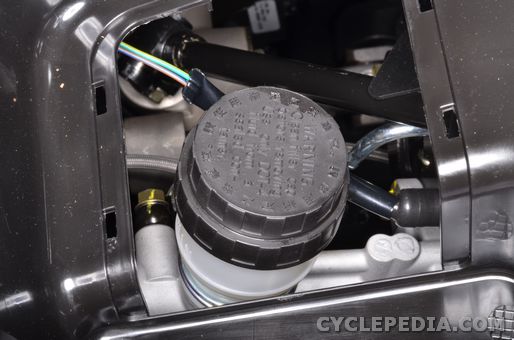There are a few different ways to bleed the brake system, some require more special tools than others. The pump and vent method only requires a wrench to open the bleeder valves, and a clear hose to a suitable container. It may require a helper if the master cylinder and caliper are not close to each other.

Remove the reservoir cap, rubber diaphragm, and diaphragm backing plate. The specified brake fluid type is often stamped on the reservoir cap. Fill the reservoir with fresh brake fluid of the correct type as the fluid level drops during bleeding.

Pull off the rubber bleeder valve cap and crack open the bleeder valve. Use a box end wrench or a 6 point socket and ratchet to prevent rounding off the head of the bleeder valve the first time it is loosened. Snug the bleeder valve back down. Place the box end of the wrench on the bleeder valve so it can be easily opened and closed.
Connect a clear hose to the nipple of the bleeder valve and place the other end of the hose in a suitable container. Squeeze the brake lever (or apply the pedal) repeatedly until pressure builds in the system and hold the lever in. Open the bleeder valve and allow the brake fluid and air bubbles to vent. Close the bleeder valve before releasing the lever. Repeat this process of building pressure and venting until air bubbles no longer exit with the brake fluid and the lever is firm.

If there are multiple calipers on the brake circuit start by bleeding the caliper farthest from the master cylinder and work back towards the master cylinder. If the system has linked front and rear brakes use the same logic or follow the specific instructions in the service manual for the model. In some cases it may be necessary to bleed the circuit at a banjo bolt to get rid of a stubborn air pocket. In this case, place a shop towel under the fitting when it is opened, and quickly clean up any brake fluid as it can quickly damage paint, finishes, and plastics. Make sure the brake fluid level is acceptable before installing the reservoir cap.
Vacuum Bleeding

Connect an Mighty-Vac or similar suction tool to the bleeder valve.

Apply a vacuum with the suction tool. Open the valve and suck the brake fluid and air bubbles out of the valve. Do not let the master cylinder run dry or air will be introduced to the system. When the air bubbles stop coming out with the brake fluid close the valve. Repeat the procedure for all calipers and inspect the lever feel. Use the pump and vent method to firm up the lever as needed.
Make sure the brake fluid level is acceptable before installing the reservoir cap.
Pressure Bleeding

Pressure bleeding requires specialized equipment. A compressed air powered diaphragm pump and bladder tank are used to generate hydraulic pressure in the system. The pump and bladder tank must be connected to the master cylinder reservoir with a special adapter. Like the other methods, a hose must be connected to the bleeder valve. The hose should terminate in a suitable container and be submerged in brake fluid. When pressure is applied by the pump and the bleeder valve is opened, brake fluid will flow through the system under pressure forcing out any air bubbles in the circuit. Close the bleeder valve when the bubbles stop coming out with the brake fluid. Repeat the procedure for all calipers and inspect the lever feel. Use the pump and vent method to firm up the lever as needed. Make sure the brake fluid level is acceptable before installing the reservoir cap.
Brake Fluid Replacement and Bleeding Video
Brake System Bleeding and ABS

ABS hydraulic brake circuits typically can be bled by the same methods as a standard hydraulic brake system- pump and vent, vacuum, and pressure bleeding are all acceptable. If air does enter the abs system, special methods, settings, or tools may be needed to complete the bleeding procedure such as using a diagnostic tool to tell the system to perform an auto bleed function.

